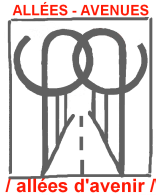- Details
- 24 Aug 2025
News
Allée, Allee, allé, aleja, alej, аллея
03 May 2018
Allee, allé, aleja, alej, аллея: these are the variations of the French word ‘allée’ in German (Allee), Swedish, Norwegian and Danish (allé), Polish, Slovenian, Latvian and Slovak (aleja), Czech (alej) and Russian (аллея).
In each case, the term refers to a street, road, path or even a canal or tram line lined with trees.
See, for example, the most beautiful "Alleen" in Switzerland: https://www.baumpflege-dietrich.ch/bern-thun-interlaken/images/pdf/medien/fachberichte/die_schoensten_alleen_der_schweiz.pdf
Or take a trip to Sweden: a tree sponsorship campaign is underway for the ‘trädallé’ (tree avenue) of the Göta Canal, a 190 km canal built in the early 19th century: https://www.gotakanal.se/sv/tradfadder/
In neighbouring Norway, the Borgestad tree avenue (Borgestadallé) was crowned ‘most beautiful road of the year’ in 2012 by the Norwegian Road Administration, for the exemplary design of this avenue and its management, which has enabled it to be maintained since 1920: http://www.side3.no/dette-er-norges-vakreste-vei/3346855.html
Last Updated: Sunday, 24 August 2025 09:11
Trees and avenues, symbols of peace
27 April 2018
BUND Mecklenburg-Vorpommern and Drogi dla Natury have set up a programme called ‘Avenues, not borders’. In 2014, the first cross-border avenue between Germany and Poland was created: avenues can be a symbol of cohesion and peace.
Trees have this power, now echoed by the two Korean leaders who will plant a tree on the border as a sign of ‘peace and prosperity’.
In 1922, in the aftermath of the Great War, Joffre embarked on a world tour to promote peace. When he arrived in the United States, he planted one of the 1,000 elm trees on Des Moines Memorial Drive.
Last Updated: Friday, 26 September 2025 13:40



